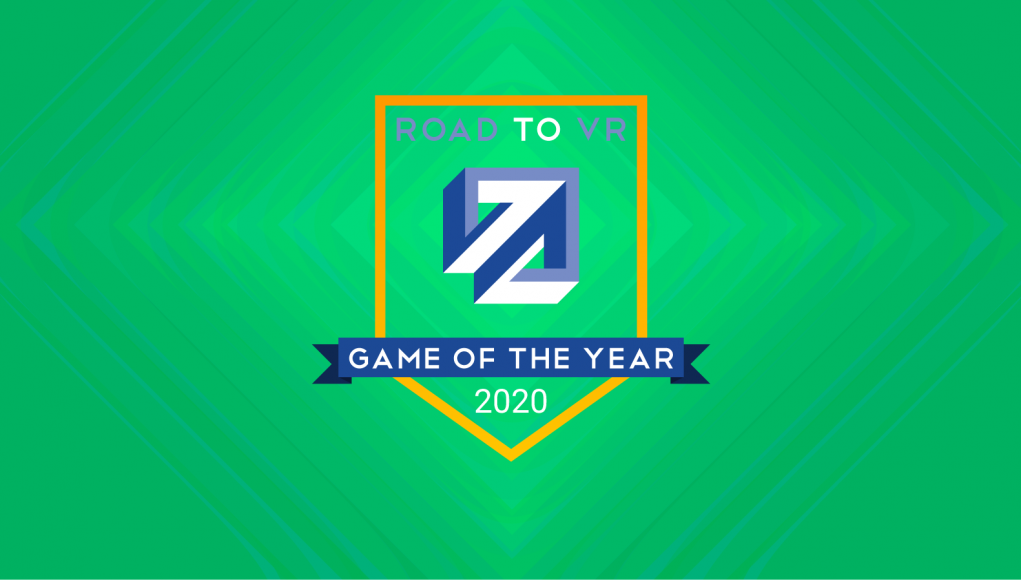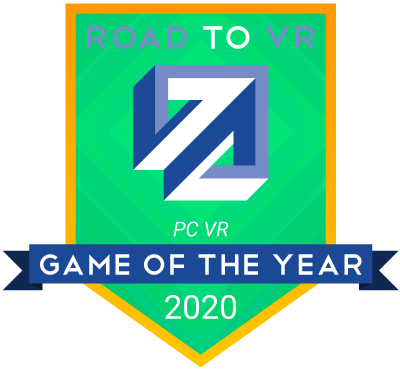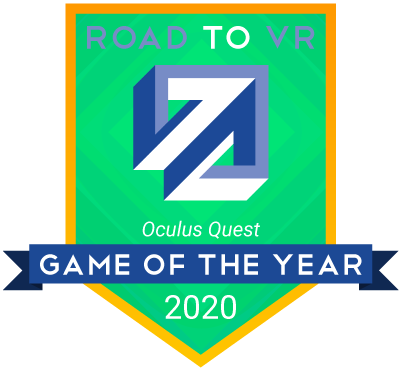It’s the time of the season again for reflection, when we look back at this year’s greatest achievements in VR gaming and remind ourselves just how far we’ve come in the four years since consumers first delved head-first into truly immersive worlds.
Due to the ongoing pandemic, this year was plunged into an global economic cooldown which saw many industries grind to a halt. Comparatively unaffected though was the games industry, which could thankfully continue as developers took to finishing their projects at home from a safe distance.
In our fourth annual Game of the Year Awards, we again put ourselves to the task of celebrating this year’s greats in VR gaming. Moreover, we salute all developers for offering up their hard work and steadfast curiosity in the face of the same personal adversity we’ve all no doubt shared. We’re grateful for having safe places where we can connect and explore, and for lighting a world which at times may have seemed grim and unrelenting.
For many, this steady stream of VR games has been a lifeline to sanity, as physically stepping outside of our homes could mean either putting ourselves or our loved ones in danger’s path. We thank you for willing your virtual realties into existence for all of us to enjoy.
Now, our games of the year:
Half-Life: Alyx
Developer: Valve
Available On: Steam
Release Date: March 23rd, 2020
If you would have told anyone back in 2016—the year the first consumer PC VR headsets hit the market—that Valve (of all companies) would one day build a AAA Half-Life game (of all franchises) specifically for VR, we’d say you were crazy. Yet here we are, in 2020, giving Half-Life: Alyx our PC VR Game of the Year Award.
But before the release of Alyx earlier this year, there was still plenty of skepticism to go around. It was Valve’s first full-fledged VR game and the first Half-Life game in more than a decade. Could Valve deliver anything to possibly meet all that hype?
Well, the answer is now resoundingly clear. It turns out that Valve’s old-school, methodical (if sometimes messy) approach to game design works just as well for VR games as it does for non-VR games.
From the very opening scene—where players are, for the first time, truly standing before the monolithic Citadel in the middle of City 17—Alyx is immersive through and through thanks to heaps of detail, an engaging and interactive world, and one of the most memorable sequences seen in any VR game to date… the dreaded ‘Jeff’.
With excellent pacing that weaves together combat, exploration, and puzzles, Alyx takes players on a seamless journey through the well-realized streets, cellars, and rooftops of City 17, all the way to a mysterious conclusion that has serious consequences for the future of the franchise.
Against all odds, one of the most legendary game developers brought one of the most legendary franchises to VR in stunning fashion. Given that the studio stood to make tens of millions (if not hundreds of millions) more in revenue by making a non-VR game, it’s hard to call Alyx anything but a love letter to the VR medium.
Half-Life: Alyx stands as VR’s new benchmark in graphics, immersion, and scope, and I’m sure that Valve itself is as eager as the rest of us to see who will be next to raise the bar.
Iron Man VR
Developer: Camouflaj
Available On: PlayStation VR
Release Date: July 3rd, 2020
While it surely brings ample opportunity, there’s nearly an equal amount of risk in using the likeness of an iconic character like Iron Man. While the character has plenty of backstory to draw from, delivering the experience of actually stepping into the character’s shoes—the experience of actually being Iron Man rather than just watching him—is no trivial task, especially in the still young and often ill-defined medium of VR.
Before Iron Man VR arrived to the rescue, there really were no standout superhero games in VR. There were attempts, certainly, but none that truly planted a flag and said “this is how it’s done.” Developer Camouflaj, however, turned out to be up to the task.
And they did it in a most ambitious way. While choosing to focus their game on a superhero that didn’t fly would have surely avoid plenty of headaches, picking one that did fly forced them to tackle the serious challenge of keeping players comfortable even as they sailed through the sky.
What’s more, the game’s innovative flying system was specially designed around Iron Man’s character—around his palm-mounted repulsor jets specifically—bringing an immersive flair to the way players control themselves in the game by aiming their hands to control thrust. The result was a truly fun and thrilling method of locomotion that balanced high-speed maneuvering with aerial combat.
But more than just coming up with a novel flight system for VR, Iron Man VR contextualized its gameplay with an engaging story that explored the man behind the mask, Tony Stark, nearly as much as his superhero persona. Combined with immersive details sprinkled throughout, Iron Man VR delivered a package that felt whole and delivered the fantasy it promised.
The Walking Dead: Saints & Sinners
Developer: Skydance Interactive
Available On: Oculus Quest, Oculus Rift, Steam, PSVR
Release Date: January 23rd, 2020
It wasn’t clear what to expect from Skydance Interactive’s take on the storied The Walking Dead zombie franchise. The Walking Dead: Saints & Sinners could have easily been a ham-handed attempt at shoehorning a standard first-person shooter into VR. We’ve seen them before, and they weren’t pretty.
As soon as you start the game though, it becomes immediately apparent that Saints & Sinners demands the player to invest themselves completely in the experience—it’s a true VR native. In this scaled-down RPG, moral choices meet zombie-killing carnage in a way we simply haven’t seen in VR up to this point. You’re instantly thrust into a world where supplies are scarce, crafting useful items is key, and coming in contact with any zombie is a fight for survival.
It’s a gruesome and realistic experience in all the right ways: a zombie can be hacked to pieces with any manner of sharp object, but you’ll lose precious stamina than you’ll need as you run away from the evening horde. If you’re a decent shot, you can try to stick to headshots the entire way, but as the mob grabs at you, you’re left with very little choice but to look them straight in the eye sockets and brain them with a knife, cleaver, or pointy stick. Complete your mission and get the hell out of dodge, or face the consequences; with each zombie presenting potential death, the horde isn’t something you’ll ever want to face.
Outside of its impressive physics-based melee and gun combat, one of the most frightening parts is navigating the muddy waters of the New Orleans gang life, where you literally choose to side with one faction by stoking blood fueds by personally executing NPCs, or by walking your own path as a freelancer. Although the adventure isn’t open-world, discrete maps are so large and rich in detail that you’ll probably forget in the first five minutes anyway.
The standalone version of the game on both Quest and Quest 2 is lower res than its PC VR forbear, but that’s saying very little. As is, the game is more than the sum of its parts, and shines even with the obligatory knock in visual fidelity for a game of this scale, polish, and depth.
Design Awards
Half-Life: Alyx
Developer: Valve
Available On: Steam
Release Date: March 23rd, 2020
Each year we try to come up with games that shine in specific departments, so we tend to highlight titles that haven’t already won our platform-based awards. This year though, there’s simply no ignoring the titanic effort that went into making Half-Life: Alyx the most immersive VR game of 2020.
From the liquid shaders inside the many errant bottles laying around, to flippable light switches, to the full baby grand piano, every object has been loving realized with one thing in mind: immersing the player into the world of Half-Life like never before.
While full, unfettered object interaction is great for immersion, this also lets players get creative with how to use seemingly banal stuff to their advantage, like carrying a basket full of grenades when you run out of space in your inventory.
In Half-Life: Alyx, there are only a few misses in terms of immersion, which are more linked to stylistic choices by Valve. You can’t melee enemies, and the gesture-based menu pulls you out a bit from the action, but even with those minor offenses, Valve has effectively created VR’s most detailed game to date that will be difficult to rival in the years to come.
Phantom: Covert Ops
Developer: nDreams
Available On: Oculus Rift, Oculus Quest
Release Date: June 25th, 2020
Building a new car is, for the most part, putting new spin on a concept that’s largely already been figured out by those that came before. While non-VR game development similarly stands on the shoulders of past giants, in VR, almost any step you take is likely to mean breaking fresh ground—right down to rethinking how players will even move around your game world.
Developer nDreams embraced the unknown and built an entire game around a novel locomotion scheme that had players sleuthing through sluices in a tactical kayak.
It might sound a little ridiculous on the surface, but dive a little deeper and you’ll see that it really fits VR well. Not only is paddling a much more immersive and intentional way to get around than using using a joystick, the kayak worked great as a sort of ‘inventory’ system for the player thanks to weapon and ammo holsters along its sides.
While a smooth moving and turning kayak could surely prove challenging from a comfort standpoint, nDreams managed to come up with a snap-turn solution that worked seamlessly with the kayak locomotion, allowing more players to enjoy their time on the waterways.
The locomotion innovation of Phantom: Covert Ops makes us excited to see what the studio comes up with next.
Star Wars: Squadrons
Developer: Motive Studios, EA Games
Available On: Steam, Epic Games, Origin, PSVR
Release Date: October 2nd, 2020
Flying an X-Wing in VR has been the dream ever since EA Games released the free X-Wing VR Mission DLC for Star Wars: Battlefront Rogue One in 2016 on PS4. And in a big way, EA’s Motive Studios delivered on that dream with this massive first-person dogfighter, which lets you play through an well-crafted singe-player campaign, or cross-platform online battles.
Motive Studios took on the mantle of making Star Wars: Squadrons feel like a native VR game which lets you play with a giant pool of players, delivering support for PC VR, traditional PC monitors, PSVR, PS4, and Xbox One players. And when it comes to dropping in for a casual dogfight, you simply can’t waste time waiting around.
To boot, playing in VR has its clear advantages, as you can naturally track enemies by looking through your cockpit’s canopy windows, all while keeping an eye on your 3D radar. One of the hopes we had for the game was motion controller support for added immersion, however simulator enthusiasts know that the most immersive way to control a vehicle in VR is using a HOTAS setup, which lets you play with physical thrusters and flight sticks so you can truly feel like you’ve stepped into your own Star Wars universe spaceship. You can also play with gamepad, which is fun too since the game offers up arcade controls instead of pure simulator-style flying like you might find in Elite Dangerous (2014).
Both the world inside and outside of your canopy is a visual treat. While cinematic cutscenes are reduced to 2D windows, the game makes up for this by putting you on the deck of each ship to speak face-to-face with some of the most detailed character models we’ve seen in VR. Crafted with motion capture, the game’s NPCs seem to inch very close to the far side of the Uncanny Valley—something you’ll appreciate more from the inside of a VR headset.
In all, Star Wars: Squadrons gives VR gamers everything it has to offer on traditional platforms and more. It also sends a clear message to AAA studios that VR doesn’t have to be a second class citizen when it can slot in so well.
Cubism
Developer: Thomas Van Bouwel
Available On: Steam, Oculus Rift, Oculus Quest
Release Date: September 17th, 2020
Cubism is a spatial puzzle game that shows that an interface can be beautiful through simplicity. The interface strikes a perfect balance between recognizable affordances and VR native flourishes like the use of depth and placement within arms reach. When it’s done the job selecting a level, it gets completely out of the way, allowing the player to directly interact with the puzzle before them.
The interface also hides a little secret which also doubles as a subtle but enjoyable means of ‘progression’ in the game. Each puzzle you complete represents a musical chord which you can hear when you select the level. Played one after another, each of these chords is part of a complete song which is every bit as beautiful in its simplicity as the interface itself. Once you complete all puzzles, the song is yours to enjoy.
There’s not much else to say—and that’s the point. Cubism’s interface does exactly what it needs to do and nothing more.
Pixel Ripped 1995
Developer: ARVORE Immersive Experiences
Available On: Steam, Oculus Rift, Oculus Quest, PSVR
Release Date: April 23rd, 2020
Indie studios take risks that larger, more established names in the industry simply won’t. And supporting those indie devs can mean playing some of the most unique and inventive games out there. Granted, there was a tad less risk involved for Pixel Ripped 1995, a retro-inspired VR game that follows in the footsteps of its popular predecessor, Pixel Ripped 1989 (2018). Still, it’s an amazingly creative slice of mid-90s nostalgia that’s expertly interwoven into the pioneering genres that made so many of us fall in love with games in the first place.
Pitching a unique ‘game within a game’ storytelling style, Pixel Ripped 1995 acts as the setting for its constant flights of fancy, mashing up the fourth console generation’s pioneering genres into a charming 3D world. Without brushing too close to infringe on any copyrights, Pixel Ripped 1995 authors a love letter to the generation’s colorful platformers, side-scrolling beat ’em ups, and RPGs.
At five hours of gameplay, it’s short and sweet, but critically doesn’t overextend itself either. Its linear gameplay offers a virtual smorgasbord of variety as you’re always left guessing at what’s next, leaving little room for boredom.
The Under Presents: The Tempest
Developer: Tender Claws
Available On: Oculus Quest, Oculus Rift
Release Date: Available from July 7th- November 15th, 2020
The Under Presents (2019) wasn’t released this year, but it did host a very special limited time immersive theater show to Oculus Quest and Rift-owning audiences that delved into some seriously interesting experimental territory. In a sea of graphical and technical marvels this year, the game’s immersive reinterpretation of William Shakespeare’s play The Tempest took the cake.
In a time when live actors are mostly out of work, The Under Presents invited expert thespians to lead groups of up to eight VR users through a rejuvenated retelling of the popular 17th-century theater piece. Built with user participation in mind, it felt more like acting in a high school theater play, with roles dolled out on the fly.
Showing up in the lobby, which is conveniently placed at the entrance of the game’s main area, participants were greeted with interesting toys and magical objects to play around with as you hang with your fellow amateur actors. Once the show begins, you’re transported to a campfire to meet a live actor, who in the show’s meta-narrative takes on the role of Prospero and many others. The guide weaves the story throughout dreamlike set pieces, and gets everyone involved in acting out parts in the story. Since players are mute, your guide acts as a professional voice over artist by filling in your lines.
In a time when interacting in large groups can be dangerous, The Under Presents The Tempest offered up a truly novel and creative experience that, even with its low-poly art style, felt like a tantalizingly real break from reality. We’re hoping to see more from developers Tender Claws in the near future, whether it be encore presentations of the experience or entirely new interactive theater pieces yet to come.
Note: Games eligible for Road to VR‘s Game of the Year Award must be available to the public on or before December 13th, 2020 to allow for ample deliberation. Games must also natively support the target platform as to ensure full operability.
















